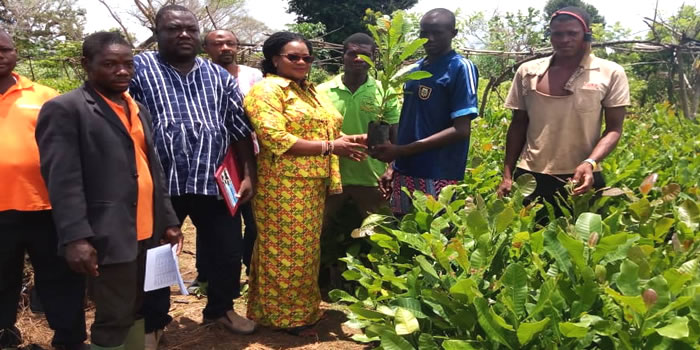

The main economic activity in the district is agriculture. About 70% of the population is involved in agriculture, which includes both crop and livestock farming. However, this is not in large scale. Other economic activities include pito brewing done by women, poetry, and weaving and small-scale blacksmithing. Shea butter extraction, and petty trading also form part of the economic activities.
Institutional Capacity
The District has an efficient and effective sixty-four (64) member Assembly as well as strong sub-district structures to enhance decision making for good governance. Added to the above is a team of dedicated and committed staff at the Assembly’s secretariat headed by an efficient, hardworking and development oriented District Chief Executive.
Decentralized and other departments play supportive and collaborative roles in the development process. Chiefs and opinion leaders in the two traditional areas contribute to the development process by mobilizing the people for development’ activities.
The summary above makes the Jirapa/Lambussie district the most appropriate destination for investment and development interventions. Potential private local and foreign investors, Donor Agencies and Non-governmental organizations are assured of a peaceful environment, vibrant economy, an unflinching support and co-operation of the Chiefs and people of the district.
Revenue
The District Assembly has two main sources of income/revenue, internally generated revenue and grants. The internally generated revenue includes rates, fees & fines, investment etc. Over the years under consideration, the Assembly seems to perform creditably by exceeding its revenue targets in 2004 and 2005 by 5% and 42% respectively. These excesses were as a result of an increase in miscellaneous receipts (unspecified receipts).
Grant is however, made up of funds from Central Government, Donor Agencies and NGOs. The funds from Central Government are: District Assembly Common Fund (DACF), HIPC and Personal Emoluments,Donor Agencies; these are European Union (EU) World Bank (CBRDP & CWSP), DWAP etc.
Expenditure
The expenditure of the District Assembly is categorized into two, i.e. Recurrent and Capital Expenditure. The recurrent expenditure is used for the day-to-day running of the Administration whereas the capital expenditure is for development projects. Donor funds are usually tied to projects and therefore solely used for capital projects. Refer to table in pdf file below.
Investment And Business Potential
Agriculture is the backbone of the district’s economy, engaging about 80% of the people. Agricultural activities are overseen by the District directorate of Agriculture, whose efficient staff operates both at the district office and through 25 operational areas. These operational areas are carefully demarcated so as to ensure that every part of the district is covered and farmers’ needs are better served.
Agricultural Extension Agents provide information on appropriate technology for improved productivity and production. Vast tracts of virgin arable land abound at Mwankuri, Han and Lambussie areas for large scale crop and livestock farming. Crops such as millet, guinea corn, maize, cotton, cowpea and groundnut thrive very well in the district’s soils.
There also exist numerous small-scale dams and dry valleys along the Volta River that could be developed into irrigation dams, for cultivation of rice, dry season vegetable farming and livestock watering. A pool of labour, comprising hardworking and energetic youth and women is always available for such productive activity.
Clay deposits exist in commercial quantizes, at places such as Tuggo, Yagha, Sabuli, Nambeg, Wulling, Billaw, Koro and Sinadindee. These can serve as prime inputs for the pottery, brick and tile industries. Studies conducted recently by AGEM, a mining company, indicate that hilly areas such as Ygha, Billaw and Hamile have gold deposits in commercial quanties, which means there is a high potential for the gold mining industry.
There are also large masses of granite and other types of rock in various parts of the district that are suitable for quarrying, which provide essential linkages for the construction industry. The Shea and dawadawa industries have high investment potential due to the fact that these trees are bountiful in the district, coupled with the fact that the women have the skills to engage in large-scale processing.
Financial Institution
Financial Control
The District Assembly exercises control over the funds through the internal control and auditing system using the financial administration decree, regulations and guidelines on the disbursement of the DACF.
Private Sector Initiatives
The Assembly has applied itself to the laudable government policy of private sector growth and the Agenda for its development. The major thrust is the support for income generating activities of groups and individuals mainly through the Poverty alleviation fund and NGO and donor sponsored projects. The latter includes Action Aid sponsored training of women in batik tie and dye and confectionary making and supply of dams, farm implements and agro-processors to communities, groups and individuals under the VIP project
Again over 400 women have benefited from a loan package of ¢101million from the Ministry of women affairs in 2002. This is to improve their income generating activities and boost their income levels.
Date Created : 11/14/2017 4:23:45 AM












 facebook
facebook
 twitter
twitter
 Youtube
Youtube
 +233 593 831 280
+233 593 831 280 0800 430 430
0800 430 430 GPS: GE-231-4383
GPS: GE-231-4383 info@ghanadistricts.com
info@ghanadistricts.com Box GP1044, Accra, Ghana
Box GP1044, Accra, Ghana